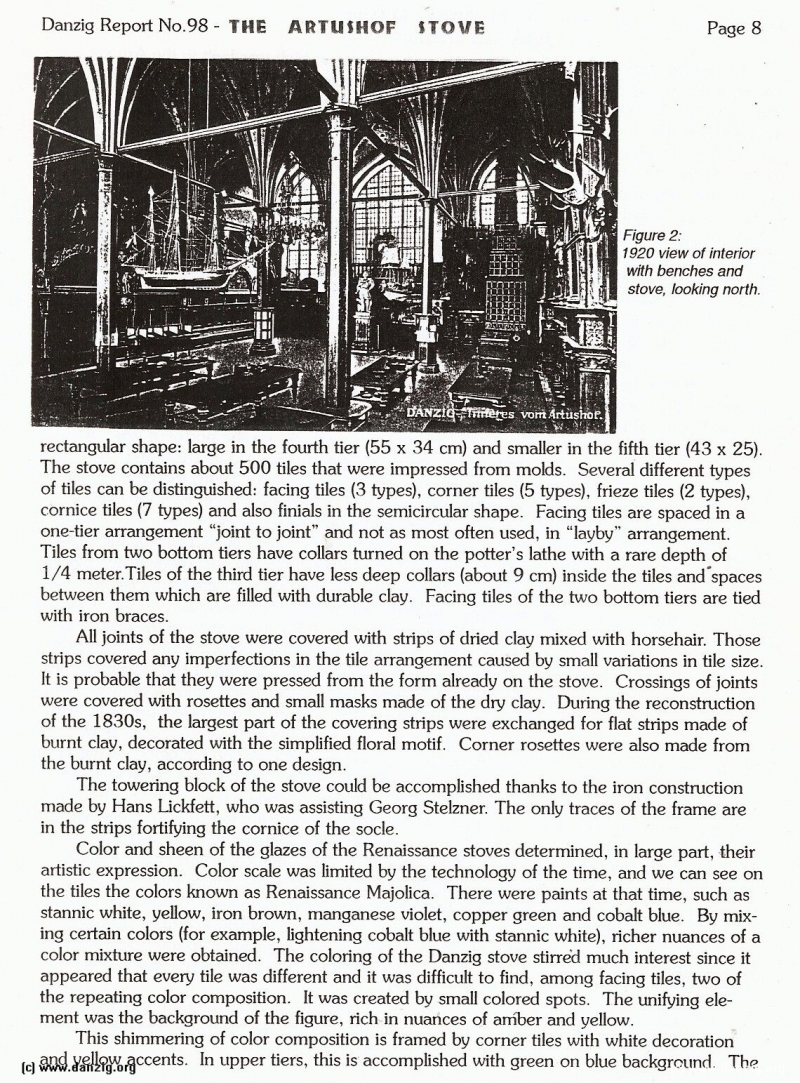
THE ARTUSHOF STOVE
Figure 2: 1920 view of interior with benches and stove, looking north.
rectangular shape: large in the fourth tier (55 x 34 cm) arid smaller in the fifth tier (43 x 25). The stove contains about 500 tiles that were impressed from molds. Several different types of tiles can be distinguished: facing tiles (3 types), corner tiles (5 types), frieze tiles (2 types), cornice tiles (7 types) and also finials in the semicircular shape. Facing tiles are spaced in a one-tier arrangement “joint to joint” and not as most often used, in “layby” arrangement. Tiles from two bottom tiers have collars turned on the potter’s lathe with a rare depth of 1/4 meter. Tiles of the third tier have less deep collars (about 9 cm) inside the tiles and spaces between them which are filled with durable clay. Facing tiles of the two bottom tiers are tied with iron braces.
All joints of the stove were covered with strips of dried clay mixed with horsehair. Those strips covered any imperfections in the tile arrangement caused by small variations in tile size. It is probable that they were pressed from the form already on the stove. Crossings of joints were covered with rosettes and small masks made of the dry clay. During the reconstruction of the l830s, the largest part of the covering strips were exchanged for flat strips made of burnt clay, decorated with the simplified floral motif. Corner rosettes were also made from the burnt clay, according to one design.
The towering block of the stove could be accomplished thanks to the iron construction made by Hans Lickfett, who was assisting Georg Stelzner. The only traces of the frame are in the strips fortifying the cornice of the socle.
Color and sheen of the glazes of the Renaissance stoves determined, in large part, their artistic expression. Color scale was limited by the technology of the time, and we can see onthe tiles the colors known as Renaissance Majolica. There were paints at that time, such as stannic white, yellow, iron brown, manganese violet, copper green and cobalt blue. By mixing certain colors (for example, lightening cobalt blue with stannic white), richer nuances of a color mixture were obtained. The coloring of the Danzig stove stirrd much interest since it appeared that every tile was different and it was difficult to find, among facing tiles, two of the repeating color composition. It was created by small colored spots. The unifying element was the background of the figure, rich in nuances of arn’ber and yellow.
This shimmering of color composition is framed by corner tiles with white decoration and yellow accents. In upper tiers, this is accomplished with green on blue background. The
Danzig Report Nr. 98 - January - February - March - 1998, Page 8.
Hits: 3719
Added: 20/05/2015
Copyright: 2025 Danzig.org

